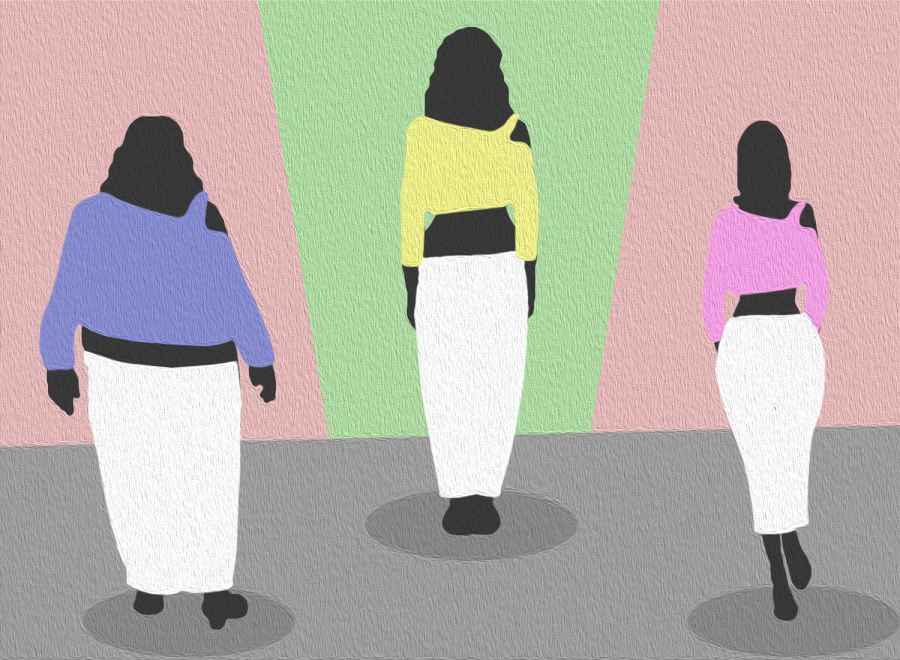Inconsistent dress codes result in unequal discipline and body shaming (Opinion)
Both within and outside of our school walls, teenage girls with certain body types have been targeted with dress code violation claims
Dress codes often target certain body types, meaning in the same shirt, some are much more likely to get dress coded.
May 10, 2022
Opinion articles represent the view of the individual writer, not necessarily The Mav student newspaper, MHS, or SVVSD.
Trends fluctuate over time: from baggy sweaters to crop tops and long skirts to short ones, change remains constant.
With these trends coming and going, one thing has definitely remained constant — the fact that often unfair dress codes seemingly target girls and non-standard body types in the community.
I, myself, have personally been a victim of unpredictable dress codes. My outfits are never out of the ordinary for a teenage girl: tank tops, pajama pants, hoodies, shorts, sweaters, and tights.
Unfortunately, because of my body, the dress code has seemed to an issue. Another student and I own the same shirt – purchased from the same store, the same day, in the sizes for our body types.
The differing factor? The other student was not bothered all day by administrators nor teachers.
Meanwhile, I was confronted with claims that I was showing too much; that I needed to “zip [my] sweater up” and was told I was only trying to get the attention of other students to distract them in class.
While I understand that body types differ, if someone else could wear the same thing as me with no comments, it’s incredibly unfair. I can’t control the larger size of my chest is or how my body is proportioned. I shouldn’t have to change the way I dress because people are bothered by a teenage girl’s body type.
SVVSD’s dress code, which is vague at best, has some understandable rules: no sharp jewelry, no drug related content/slogans on shirts, etc. One of these rules sticks out more than the others and goes as follows: “clothing that bares or exposes traditionally private parts of the body including, but not limited to, the stomach, buttocks, back and breasts.”
This begs the question…
What is considered traditional? What does this mean by breast? Cleavage? How much is considered too much? It seems nipples should not be out — but should cleavage be censored? This is something that people cannot control. Nobody can control the size of their chest.
“Traditionally private parts of the body, but not limited to…”
Are these parts allowed or are they not? At Mead High School, it seems to depend on the day.
At MHS, the chances of being dress coded are either at the highest highs or the lowest lows.
Admin seem quick to dress code shirts advertising beer or guns, but there seems to be gray area when it comes to clothing such as simple tank tops.
When you consider my original, the time my friend and I wore the same exact shirt in our respective sizes and only one of us was dress-coded, I was told that perhaps the outfit just “fit differently” on me, that maybe more of my body was showing than I realized, that maybe I was more exposed than I thought.
The issue still lies though. If another student can wear this shirt, why can’t I do the same? Why can’t those that look similarly to me? Everyone should be allowed to wear what makes them comfortable, not just one certain group of people.
The problem with dress codes doesn’t exist only at MHS; this is a nationwide problem.
The problem is not the girls across America.
The issue is that adults appear to be ruling over how young women should dress. The sexualization and shaming of young girls is a problem that many are in denial about. Rather than “protecting” women by dictating what they wear, teaching people to be respectful should be the goal.
Different schools across the nation have wrongly punished and shamed students for what they wear. In 2017, Molly Neuner, a sixth grader from Maine, challenged her school’s dress code. She wore multiple tank tops throughout the school week, protesting the school’s dress code.
“I decided to totally break the dress code, and I didn’t care what the teachers or anyone said because it’s my body, my choice,” she said.
In 2018, college student Gina Capone wrote an article calling out a new policy Rowan University placed. This policy targeted sports bras, more specifically the ban of wearing them as tops.
The solution to all of this? Creating a dress code that doesn’t target students. That seems hard, but it isn’t. Dress codes shouldn’t be used as a weapon. An even better solution? Rather than banning specific articles of clothing, schools should encourage every student to respect themselves and others.
Alameda Unified School District in California released a dress code that gives students the ability and freedom to wear what makes them comfortable.
Another dress code that offers flexibility and equality is the Oregon NOW Model Student Dress Code.
“Student dress codes and administrative enforcement should not reinforce or increase marginalization or oppression of any group based on race, gender, ethnicity, religion, sexual orientation, household income, gender identity or cultural observance,” said the Oregon NOW dress code.
Schools and districts alike should be more focused on telling students what they can wear, not banning on the specifics. This narrows down clothing choices and creates inequalities among students.
At the end of the day, people should be able to express themselves. Students should be able to be comfortable. Everybody should be taught consent, respect, and have the ability to treat everyone equally. And that doesn’t appear to be happening.



Lilah • May 11, 2022 at 3:57 pm
Thank you for making this honestly it makes me feel better about myself and I was just made fun off for a shirt I was wearing cause it was cropped and when I reached my hands up it should a bit of my stomach like all the others girls it just annoying some times that we can’t wear specific things cause of dress codes or dumb things like that us girls can’t control anything about are body and some of us wish we could but we can’t thank you again for this article-Lilah Tovar